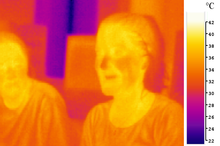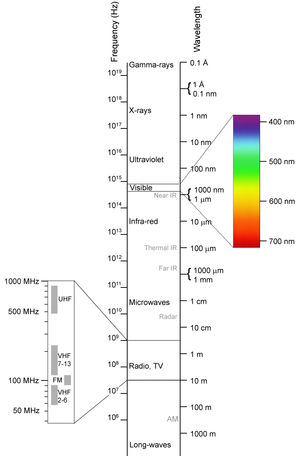Infrared (IR) light is electromagnetic radiation with a wavelength longer than that of visible light, measured from the nominal edge of visible red light at 0.74 micrometres (µm), and extending conventionally to 300 µm. These wavelengths correspond to a frequency range of approximately 1 to 400 THz, and include most of the thermal radiation emitted by objects near room temperature. Microscopically, IR light is typically emitted or absorbed by molecules when they change the irrotational-vibrational movements.
Infrared light is used in industrial, scientific, and medical applications. Night-vision devices using infrared illumination allow people or animals to be observed without the observer being detected. In astronomy, imaging at infrared wavelengths allows observation of objects obscured by interstellar dust. Infrared imaging cameras are used to detect heat loss in insulated systems, observe changing blood flow in the skin, and overheating of electrical apparatus.
Much of the energy from the Sun arrives on Earth in the form of infrared radiation. Sunlight at zenith provides an irradiance of just over 1 kilowatt per square meter at sea level. Of this energy, 527 watts is infrared radiation, 445 watts is visible light, and 32 watts is ultraviolet radiation. The balance between absorbed and emitted infrared radiation has a critical effect on the Earth's climate.
Main Applications:
- Night Vision: Infrared is used in night vision equipment when there is insufficient visible light to see. Night vision devices operate through a process involving the conversion of ambient light photons into electrons which are then amplified by a chemical and electrical process and then converted back into visible light. Infrared light sources can be used to augment the available ambient light for conversion by night vision devices, increasing in-the-dark visibility without actually using a visible light source. The use of infrared light and night vision devices should not be confused with thermal imaging which creates images based on differences in surface temperature by detecting infrared radiation (heat) that emanates from objects and their surrounding environment.
- Hyperspectral Imaging:
A hyperspectral image, a basis for chemical imaging, is a "picture" containing continuous spectrum through a wide spectral range. Hyperspectral imaging is gaining importance in the applied spectroscopy particularly in the fields of NIR, SWIR, MWIR, and LWIR spectral regions. Typical applications include biological, mineralogical, defence, and industrial measurements.Thermal Infrared Hyperspectral Camera can be applied similarly to a Thermographic camera, with the fundamental difference that each pixel contains a full LWIR spectrum. Consequently, chemical identification of the object can be performed without a need for an external light source such as the Sun or the Moon. Such cameras are typically applied for geological measurements, outdoor surveillance and UAV applications - Heating: Infrared radiation can be used as a deliberate heating source. For example it is used in infrared saunas to heat the occupants, and also to remove ice from the wings of aircraft (de-icing). FIR is also gaining popularity as a safe heat therapy method of natural health care & physiotherapy. Infrared can be used in cooking and heating food as it predominantly heats the opaque, absorbent objects, rather than the air around them.
Infrared heating is also becoming more popular in industrial manufacturing processes, e.g. curing of coatings, forming of plastics, annealing, plastic welding, print drying. In these applications, infrared heaters replace convection ovens and contact heating. Efficiency is achieved by matching the wavelength of the infrared heater to the absorption characteristics of the material.
























.jpg)


